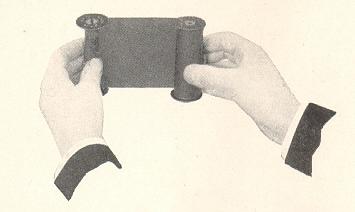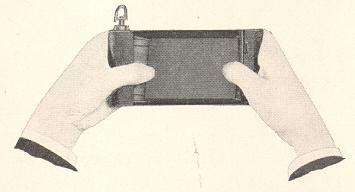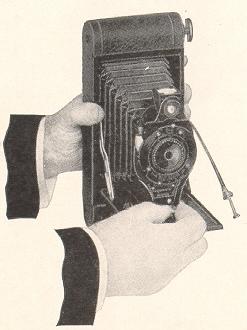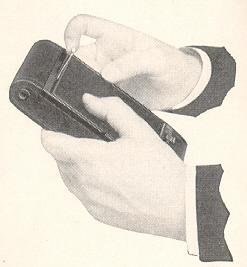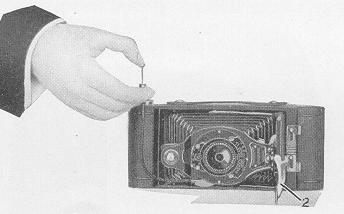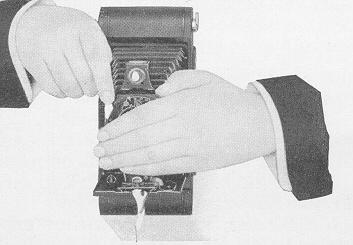If you find this manual
useful,
how about a donation of $3 to:
M. Butkus, 29 Lake Ave.,
High Bridge, NJ 08829-1701
and send your
e-mail address
so I can thank you.
Most other places would charge
you $7.50 for a electronic copy
or $18.00 for a hard to read Xerox copy.
This will help me to continue to host this site,
buy new manuals,
and pay their shipping costs.
It'll make you feel better, won't
it ?
If you use Pay Pal, use the link below.
Use the above address for a check, M.O. or cash.
Back to main camera manual page
CLICK HERE TO CONTINUE TO WORD DOCUMENT
MADE FROM FILE BELOW
(BETTER
PRINTING)
Click
here for Rainbow Hawk-Eyes
PDF made from file below
(This camera takes standard
120 film. Color film is easier
to
process, but these lenses
are not coated)

SERVICE
DEPARTMENT
ADDITIONAL ASSISTANCE FOR
MAKING BETTER PICTURES
ALTHOUGH we give in this manual the essential directions for using the camera
it accompanies, there are amateurs who wish for
further knowledge of photography.
The Service Department is at their service, your service.
Do not hesitate to call on us for information on any photographic subject.
We are at your service, write to us--there is no charge, no obligation.
Address all Communications
SERVICE DEPARTMENT
EASTMAN KODAK COMPANY
ROCHESTER, N. Y.
Picture taking with the
Rainbow Hawk-Eyes
Nos. 2 and 2A Folding
Model B
Single Lens
(Meniscus Achromatic)
Published by
EASTMAN KODAK COMPANY
ROCHESTER, N. Y.

IMPORTANT
BEFORE taking any pictures with your camera, and before loading it with film read these instructions carefully; Take especial care to learn how to operate the shutter.
While loading and unloading, be very careful to keep the protective paper wound tightly around the film to prevent light striking it. The camera can be loaded or unloaded in daylight.
This should be done in a subdued light, not in direct sunlight.
TO LOAD
 |
Use film number 120 for the Rainbow Hawk-Eye No. 2; number 116 for the Rainbow Hawk-Eye No. 2A.
Slide back the lock. Take the front of the camera by the edges and lift the end on which the lock is fastened, , drawing out that part of the camera as illustrated.
Draw on the winding key as far as it will come, and remove the empty spool.
Remove the paper band, unfold the end of the protective paper and thread it as far as it will go,
into the longer opening of the slit in the empty spool. Each spool has one end slotted and the protective paper must be inserted in the empty spool so that the slotted ends are on
opposite edges of the paper.
|
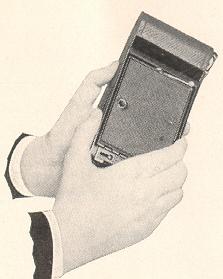 |
The word "TOP" printed on the protective paper must be next to the slotted end of the reel. Give the
empty spool three or four turns, enough to bind the paper on the reel. The paper must draw straight, and the full spool must not loosen.

|
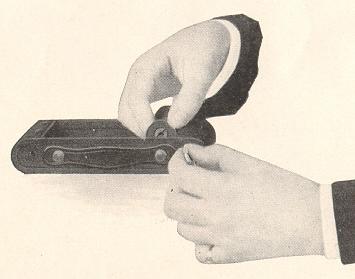 |
Place the two spools into the film pockets at each end of the camera, keeping the paper taut, as shown above. |
Important:
The empty spool or reel must be placed in the winding key end of the camera with its slotted end towards the winding key.
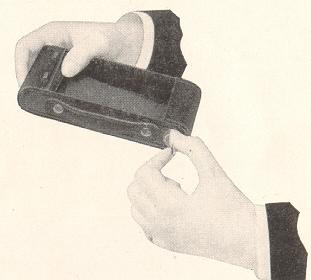 |
Push the full spool into the other pocket as far as it will go, so that the tension spring grips it.
Press in and turn the winding key until it fits into the slot in the empty spool or reel.
|
After the camera is loaded, replace the front, first inserting the end opposite the lock; the edge of the box must fit into the groove on this end of the front. Press the end on which the
lock is fastened into place, and push over the lock.
Press in and turn the winding key and watch the red window. After a few turns, a warning hand will appear, then turn the key slowly until the figure 1 is in the center of the window.
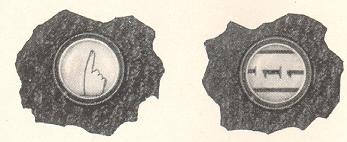 |
The film is now in position for the first exposure. After each exposure be sure to wind the film, bringing the next number into place.
This prevents making two pictures on the same section of film. |
OPENING THE FRONT OF CAMERA
Raise the lever near the winding key, and draw down the bed of the camera, until the bed
braces catch.
Draw out the lens standard by the knob on the slide plate, to the slot marked 100
feet, where it will lock automatically.
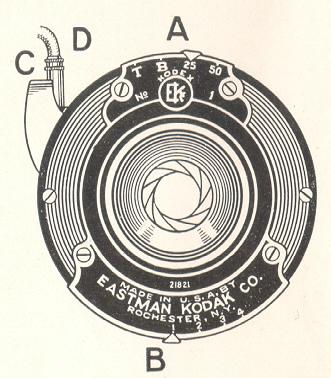
Instantaneous Exposures
"Snapshots"
|
f/stop |
4 |
5.6 |
8 |
11 |
16 |
22 |
32 |
45 |
|
U.S. |
1 |
2 |
4 |
8 |
16 |
32 |
64 |
256 |
| |
|
|
|
1 |
2 |
3 |
4 |
|
If you are using a light meter... Opening 1 would be an F4, 2 a F5.6,
Move the indicator A to 25 or 50 according to the time of Instantaneous Exposure required,
and move the lever B to the correct stop opening, see the Exposure Guide on the back cover,
or the table on pages 15 and 16.
Press the push-pin of the cable release D or press the exposure lever C. This makes the exposure.
Time Exposures
Move the indicator A to the letter "T" (time).
Move the lever B to No. 1, 2, 3 or 4 depending on the time of the exposure and the nature
of the subject. See tables on pages 15, 16, 27, 28 and 32.
Press the push-pin of the cable release D or press the exposure lever C. This opens the
shutter. Time the exposure by a watch. Again press the push-pin or the exposure lever. This
closes the shutter.
For short time exposures of ten seconds or less, "Bulb" Exposures are recommended.
"Bulb" Exposures
Move the indicator A to the letter "B" (bulb).
Move the lever B to No. 1, 2, 3 or 4. See tables on pages 15, 16, 27, 28 and 32.
Press the push-pin of the cable release D or press the exposure lever (I, to open the shutter,
and release it to close the shutter. This makes the exposure.
Never make Time or "Bulb" Exposures with the camera held in the hands.
Important: Never oil the shutter.
In case of accident, return the camera to your dealer or to us for repairs.
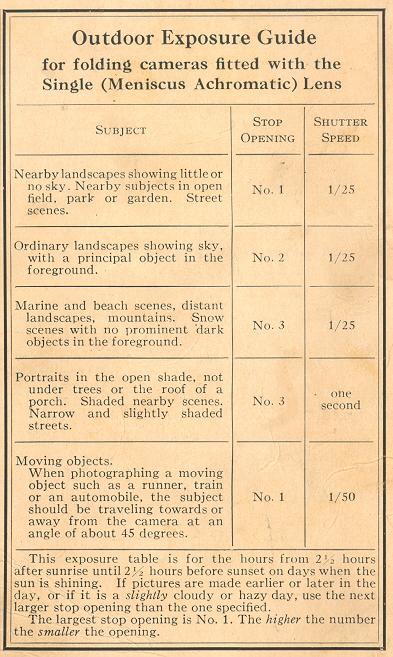
TO FOCUS THE CAMERA
On the bed of the camera is a focusing scale, with slots marked 8, "Fixed" (25 feet) and
100 feet. The scale is marked both for feet and meters and care should be taken not to confuse the figures.
When the lens standard is drawn out to the slot marked 100 feet, the camera is in focus for anything 100 feet or beyond.
To adjust the focus for subjects at distances nearer than 100 feet, press the spring catch or
locking device on the side at the bottom of the lens standard, and draw out the standard to the
slot marked 8 or "Fixed" (25 feet), depending upon the estimated distance between the camera
and the principal object to be photographed, see Depth of Focus Tables on page 13.
The distance between the subject and camera can be estimated without measuring, unless
the subject is close to the camera; for instance, if the focus is set at the slot marked "Fixed"
(the usual distance for ordinary street scenes), everything from about fourteen feet to about
seventy-five feet will be in good focus. When the camera is focused in this manner, it may be
used as a regular fixed focus camera, see page 12. When the principal object is nearby or at a
great distance, the focus should be changed accordingly.
For distant views, set the indicator in the slot marked 100 feet, and when the subject is
about eight feet from the lens, set the indicator in the slot marked eight feet. When the camera
is focused for eight feet, the subject can be about five feet from the camera if the smallest
stop opening is used, see table on page 13. A time exposure will be necessary when using the
smallest stop opening. The subject can be closer than five feet to the lens if a Kodak Portrait
Attachment is used, see pages 30 and 31.
How to Use the Rainbow Hawk-Eye
No. 2 or No.
2A Folding as a Fixed Focus Camera
SET THE Focus AT "FIXED."
MOVE STOP OPENING LEVER TO NO. 1.
USE SPEED 25.
When using the camera as a fixed focus type, nearby subjects must be in bright sunlight, to obtain fully exposed negatives.
The range of sharpness when your Hawk Eye is adjusted as a fixed focus camera will be found in one of the tables on page 13.
DEPTH OF FOCUS
Depth of focus is the distance from the nearest to the farthest objects that will appear sharp
in the negative or print. The depth of focus of any lens depends upon the size of the stop
opening used. The smaller the stop opening the greater the depth of focus. See the following
tables for the depth of focus or range of sharpness of the Rainbow Hawk-Eyes Nos. 2 and 2A
Folding:
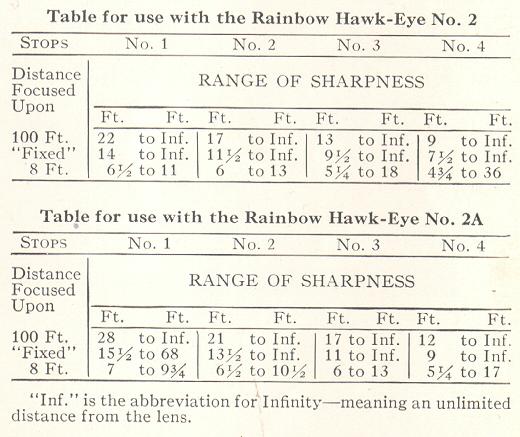
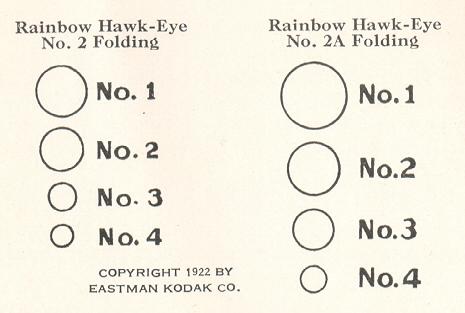
These circles are the same size as the stop openings of the shutters on the Rainbow Hawk-Eyes Nos. 2 and 2A Folding, when they are fitted with the Single (Meniscus Achromatic)
Lens. They show the relative sizes of the stop openings and how their areas differ.

The above diagram shows the relative lengths of exposure required with the different stop openings.
STOP OPENINGS
The stop openings regulate the amount of light passing through the lens. The openings are enlarged or reduced by moving the lever B. see page 9.
Each opening marked with a higher number is half the size of the preceding opening
marked with a lower number, and admits approximately half the light. No. 1 is the largest opening.
The exposures must be doubled for each succeeding higher number (smaller stop opening).
For example: If the correct exposure using stop No. 1 is speed 50, the equivalent exposure
using stop No. 2 will be speed 25. See comparative exposures using different stop openings given on page 27.
No. 1
--For all ordinary outdoor pictures, such as nearby landscapes showing little or no sky,
groups and street scenes, when the subject is in bright sunlight, use speed 25; for moving objects in bright sunlight, use speed 50.
No. 2
--For open views, when the sunlight on the subject is unusually strong and there are no
heavy shadows, such as views at the seashore and on the water use speed 50, for ordinary
landscapes, in bright sunlight, with clear sky overhead, use speed 25; also for Interior Time Exposures, the time for which is given in the table on page 28.
No. 3
--For instantaneous exposures of extremely distant landscapes, marines, snow scenes
with no prominent dark objects in the foreground, and clouds only, in bright sunlight, use
speed 25; also for portraits outdoors, see pages 29 and 30, and other Time Exposures, see pages 27 and 32.
No.4
-- For Time Exposures Outdoors on cloudy days, see page 32. For portraits outdoors,
see pages 29 and 30; and for Interior Time Exposures, see page 27. Never for instantaneous exposures.
The smaller the stop opening the greater the depth of focus, see page 13.
Failure will result, if stop No. 4 is used for instantaneous exposures.
All the exposures given for outdoor subjects are for the hours from two and a half hours after sunrise until two and a half hours before sunset.
If earlier or later the exposures must be longer.
For subjects in the shadow, under porches or under trees' no definite directions can be given; experience only can teach the correct exposure to give.
THE FINDER
The finder shows what will appear in the picture, but on a much reduced scale.
Look into the finder from directly over the center of it and include what is wanted by turning to the right or left, see illustration on page 18.
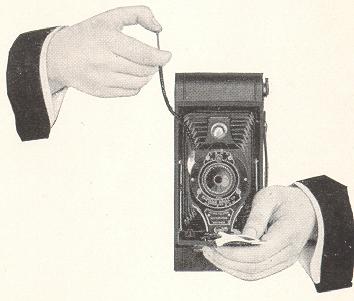
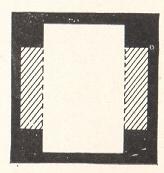 |
To make a vertical picture, hold the camera as shown above. Only what is seen in that part of the finder shown as white in the diagram, will appear in the picture. |
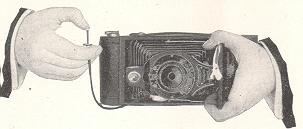
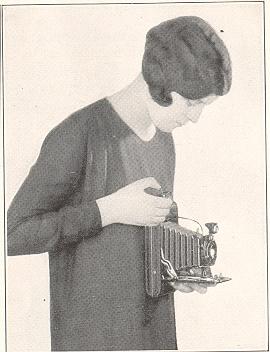 |
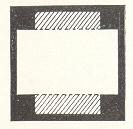
When making instantaneous exposures or snapshots with any camera, hold it firmly against the body as shown. When pressing the push-pin or the exposure lever, hold the breath for the
instant. If the camera is moved during the exposure, the picture will be blurred.
To make a horizontal picture, turn the finder and hold the camera as shown above.
Only what is seen in that part of the finder shown as white in the diagram, will appear in the picture. |
MAKING INSTANTANEOUS EXPOSURES OR SNAPSHOTS
When ordinary instantaneous exposures or snapshots are made, the subject should be in the broad, open sunlight, but the camera must not. The sun should be behind your back or over
the shoulder. If it shines directly into the lens it will blur and fog the picture.
Special instructions for making portraits are given on pages 21, 29, 30 and 31.
HOLD THE CAMERA LEVEL
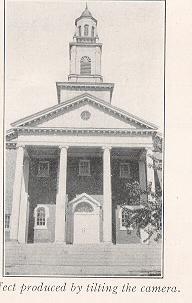 |
The camera must be held level. If all the subject cannot be included in the finder without
tilting the lens upwards, move backwards until it is all included with the camera held level.
If the subject is below the normal height, like a small child or a dog, the camera should be held down level with the center of the subject. |
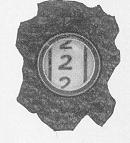 |
After an exposure has been made, turn the winding key slowly, a few times, until No. 2 or
the next number is in the center of the red window.
Turn the film immediately after making each exposure; this prevents making two pictures on the same section of film. |
CLOSING THE CAMERA
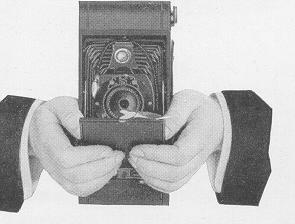 |
Release the spring catch on the lower part of the lens standard, from the slot in the focusing scale, and slide back the lens standard as far as it will go.
Place the cable release around the shutter, press the bed braces at each side of the standard and raise the bed.
Caution: The lens standard must be pushed back as far as it will go, or it will interfere with the bed when closing. |
REMOVING THE FILM
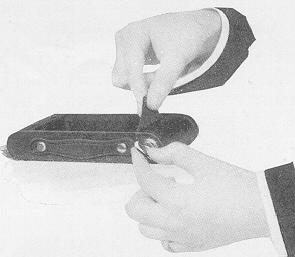 |
After the last section of film has been exposed, turn the winding key until the end of the
paper passes the red window.
In a subdued light, remove the front of the camera as described on pages 3 and 4.
|
Hold the end of the paper taut and turn the key until all but about an inch of the paper is on the roll. If the sticker folds under the roll, turn the winding key to bring it up.
Take hold of the ends of the paper and sticker to prevent paper from loosening. Draw out
the key and remove the roll of film. Fold under about half-an-inch of the protective paper, and fasten it with the sticker.
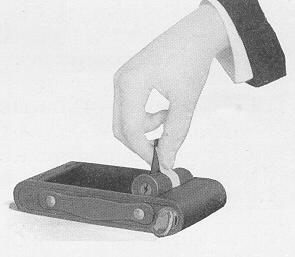 |
"Cinch" Marks: After removing the film from the camera, do not wind it tightly with a
twisting motion, or the film might be scratched.
Wrap up the exposed film. It is now ready for development. This may be done by a photo
finisher, or by yourself. If the latter is desired, you may write to our Service Department,
mentioning the size of the pictures made with your camera, and we will send you a list of the
necessary materials which can be ordered from your dealer. |
Important: Film should be developed as soon as possible after exposure. The
quality of the image on all sensitized products is retained by prompt development after
exposure.
Remove the empty spool and place it in the winding end of the camera.
Replace the front of the camera as described on page 6.
The camera is now ready for reloading.
It is a good plan to reload the camera as soon as an exposed film has been removed, to be
ready for the next pictures. Load with Kodak Film.
TIME EXPOSURES--INDOORS
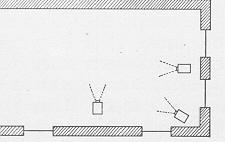 |
Open the front of the camera as described on page 8. For time exposures the camera must
always be placed on a firm support like a tripod, Optipod, table or chair, never hold it in the
hands. It has two tripod sockets for use with a tripod or an Optipod. |
Place the camera in such a position that the finder will include the view desired. The above
diagram shows three positions for the camera. It should not be pointed at a window as the glare of light will blur the picture. If all the windows can not be avoided,
draw the shades of those within range of the lens.
If the camera is placed on a table, use the locking lever 2, as a support. The camera must not be more than two or three inches from the edge of the table.
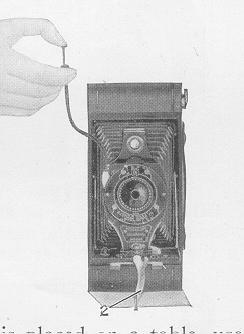 |
For horizontal pictures, turn the camera finder and locking lever 2, as on page 26.
Focus the camera as described on pages 11 and 12.
Adjust the shutter for a time exposure, see page 10.
All being ready, press the push-pin or the exposure lever carefully, once to open,
time the exposure by a watch, and again press the push-pin or the exposure lever to close the shutter. |
After making a time exposure, turn the winding key until the next number appears in the
red window. If no more time exposures are to be made, adjust the shutter for an instantaneous exposure, see page 9.
Another method of making time exposures is to hold the hand or a card close to the shutter,
open the shutter and take the hand away for the length of exposure required, return the hand and close the shutter. See illustration at bottom of page 26.
Exposure Table for Interiors
The table on page 28 gives suitable exposures for varying conditions of light, when using stop No. 2.
With stop No. 1, give one-half;
"
" No. 3, " twice;
" " No. 4, " four times the exposures given in the table.
The smaller the stop opening the greater the depth of focus, see page 13. Stop No. 2 gives the best average results for Interiors.
TO MAKE A PORTRAIT
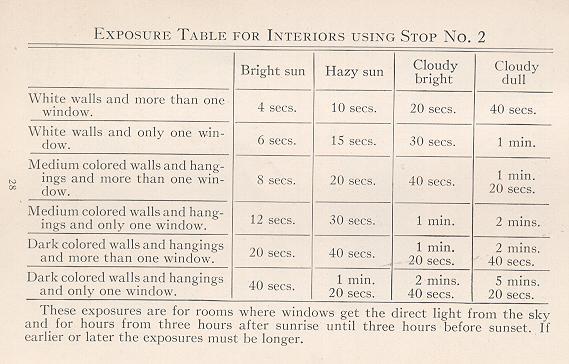
The subject should be seated in a chair partly facing the light with the body turned slightly
away from, and the face turned towards the camera which should be a little higher than an
ordinary table. The subject should look at an object level with the lens, or directly at the lens.
Compose the picture in the finder. For a three quarter figure the camera should be about
eight feet from the subject; and for a full length figure about ten feet. When the subject is ten
feet from the camera, place the focusing indicator in the slot marked eight feet and use stop
No. 2, see tables on page 13. The background should form a contrast with the subject; a light
background usually gives a better effect than a dark one.
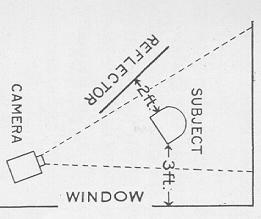 |
To get a good light on the face, follow the arrangement shown in the diagram. A reflector
helps to get detail in the shaded part of the face. A white towel or tablecloth held by an assistant or thrown over a screen or other high piece of furniture will make a
suitable reflector; it should be at an angle and in the position indicated in the diagram. |
Making Portraits Outdoors
When making portraits outdoors, with the sun shining brightly, the subject should be in the
shadow of a building or a large tree, but with clear and unobstructed sky overhead. Place the camera on a tripod or other steady support, use stop No. 3 or No. 4 and make a "Bulb" Exposure of about one or two seconds. By following this rule unpleasant and
distorting shadows on the face will be avoided.
Kodak Portrait Attachment
The Kodak Portrait Attachment makes head and shoulder portraits. It can also be used for photographing flowers and similar subjects.
Place the Attachment over the lens opening and compose the picture in the finder.
The subject must be at one of the distances from the camera, given in the table below. Measure the distance carefully from the lens to the face, and place the focusing indicator according to the table:
| DISTANCE BETWEEN SUBJECT AND LENS MUST BE |
THE FOCUSING INDICATOR MUST BE MUST BE SET AT |
2 feet 9 inches
3 ' - 8 "
4 ' - 2 " |
8 feet
"Fixed"
100 feet |
When making portraits, the most pleasing results are obtained with the subject four feet two inches
from the lens and the focus set at 100 feet. For flowers and similar subjects the shorter distances will be more satisfactory.
The exposure when using the Attachment is the same as without it.
Use Kodak Portrait Attachment No. 8 with the Rainbow Hawk-Eye No. 2 Folding; and use No. 3
with the Rainbow Hawk Eye No. 2A Folding.
Kodak Diffusion Portrait Attachment
The Kodak Diffusion Portrait Attachment is a supplementary lens used in the same manner as the regular Kodak Portrait Attachment. It produces a true, soft-focus effect.
Use Kodak Diffusion Portrait Attachment No. 8 with the Rainbow Hawk-Eye No. 2 Folding, and use
No. 3 with the Rainbow Hawk-Eye No. 2A Folding.
"AT HOME WITH THE KODAK" is a booklet containing many diagrams and illustrations showing various lighting effects. It gives suggestions for making pictures, in and around the home.
"PICTURE TAKING AT NIGHT" is a booklet that describes in detail the methods of making flash-light exposures, campfire scenes, fireworks, lightning, moonlight effects, silhouettes and other novel
and unusual pictures.
These two booklets are free, and copies of them will be sent upon request to our Service Department.
TIME EXPOSURES--OUTDOORS
When the smaller stop openings (NO. 3 or No. 4) are used, the light passing through the lens is so much reduced that very short time exposures outdoors may be made.
For short time exposures as described below, use the "Bulb" Exposure, see page 10.
With Light Clouds--From one to three seconds will be sufficient.
With Heavy Clouds--Four seconds to eight seconds will be required.
With Sunshine--The shutter can hardly be opened and closed quickly enough to avoid over-exposure.
CARE OF THE CAMERA
Caution: Prolonged exposure to direct sunlight might cause the colored covering of the camera to fade. Do not use alcoholic solvents for cleaning the camera.
Keep Dust Out of the Camera
Wipe the inside of the camera and bellows, occasionally, with a slightly damp cloth, especially if the camera has not been used for some time.
Clean Lenses
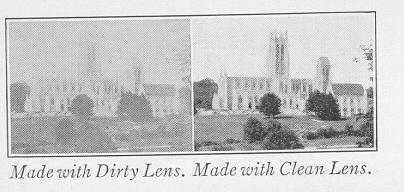 |
The pictures at the top of page 33 illustrate the difference between the results with a dirty and clean
lens. |
Lenses should be cleaned as follows:
Remove the front of the camera, see pages 3 and 4, then open the front as described on page 8.
Adjust the shutter for a Time Exposure and open it; the largest stop opening (No. 1) should be in
position. Wipe the front and back of the lens with a clean handkerchief. Never unscrew the lens.
EASTMAN KODAK COMPANY,
ROCHESTER, NEW YORK.
PRICE LIST
KODAK FILM CARTRIDGE, No. 120, for the Rainbow Hawk-Eye No. 2 Folding 2
1/4 x 3 1/4 of, six exposures $ .25
KODAK FILM CARTRIDGE, No. 116, for the Rainbow Hawk-Eye No. 2A Folding, .
21/4 x 41/4, twelve exposures .60 Six exposure $ .30
KODAK PORTRAIT ATTACHMENT, No. 8, for the Rainbow Hawk-Eye No. 2 Folding .75
No. 3, for the Rainbow Hawk-Eye No. 2A Folding .75
KODAK DIFFUSION PORTRAIT ATTACHMENT, .
No. 8 $1.25
No. 3 $1.25
KODAK SKY FILTER, No. 8 $.75
No. 3 $1.15
KODAK COLOR FILTER, No. 3 $.75
No. 3 $1.15
KODAK METAL TRIPOD, No. 0 $2.75
N 0. 1 . ........... ... .$4.50
No. 2 $. . . . . .. 5.00
LEATHER CARRYING CASE, for Kodak Metal
Tripod Nos. 0, 1 or 2 2.70
OPTIPOD, for attaching camera to the edge of a table, chair, fence, etc $1.25
KODAPOD, for attaching camera to a tree
fence or similar rough surface $1.75
KODAK SELF TIMER, fits on the cable release and automatically presses the push-pin enabling the photographer to be included.
$1.25
KODAK NEGATIVE ALBUM, to hold 100 21/4 x 31/4 or smaller negatives $1.25
KODAK NEGATIVE ALBUM, to hold 100 2 1/4 x 4 1/4 or smaller negatives $ 1.25
KODAK TRIMMING BOARD No. 2, capacity 7 x 7 inches $1.00
KODAK DRY MOUNTING TISSUE, 2 1/4 x 3 1/4 or 2 1/2 x 4 1/4, three dozen sheets
$.10
RHODES ALBUM, flexible leather cover, size 7 x 11, loose-leaf, 50 black leaves
$2.75
Cloth cover, size 7 x 11 $1.25
VELOX TRANSPARENT WATER COLOR STAMPS, booklet of twelve colors $.50
VELOX WATER COLOR OUTFIT, consisting of Artist's Mixing Palette, three Camel's Hair Brushes and one book of Velox Trans parent Water Color Stamps (twelve colors)
$1.00
"How TO MAKE GOOD PICTURES, an illustrated book of helpful suggestions. It describes various methods of making
exposures, developing, printing, enlarging, coloring, making lantern slides, and other interesting subjects
$.50
All prices stabled to change without notice.
EASTMAN KODAK COMPANY,
ROCHESTER, NEW YORK
Velox now identifiable
To
protect Kodak amateurs, and to protect Developing and Printing houses that endeavor to give their customers the best
possible results, we have made Velox paper identifiable. The trade name "Velox" is printed, faintly, on the back of every sheet. Look for it.
Insist on Velox--the paper that exactly meets the requirements of amateur negatives--and know you're getting the best possible results from yow films.
The Velox Book tells the working of a simple paper in simple terms--a valuable photographic help. Free from us or your dealer.
The Kodak Portrait Attachment
Fits your Rainbow Hawk-Eye for head and shoulder portraits--it enables you to approach closer to the subject and get a larger image, sharply focused at short range.
At your dealer's
EASTMAN KODAK COMPANY
ROCHESTER, N. Y.
A PRACTICAL book for amateurs. It describes in a simple, understandable way every phase of photography that they are likely to be interested in, such as various methods of making
exposures, developing, printing, enlarging, coloring, making lantern slides, and other interesting subjects. Profusely illustrated.
EASTMAN KODAK COMPANY
Sold at your dealer's ROCHESTER, N.
IMPORTANT
Read this manual thoroughly before you make any pictures.
While loading and unloading the camera, be very careful to keep the protective paper wound tightly around the film to prevent light striking it.
Before making an exposure be sure that the shutter is adjusted properly, using the correct stop opening and speed.
The camera must be focused and an unexposed section of film in position.
The sun must be behind your back or over the shoulder. If the sun shines directly into the lens it will blur and fog the picture.
Hold the camera level.
Hold the camera steady when making instantaneous exposures or snapshots. The camera should be held firmly against the body and when pressing the push-pin or the
exposure lever, hold the breath for the instant. If the camera is moved during the exposure, the picture will be blurred.
Turn a new section of film into position immediately after making an exposure. This will prevent making two pictures on the same section of
film.
Never oil the shutter.
Keep the lens and inside of the camera clean.
Instructions for making time exposures, indoors and outdoors, are included in this manual.
EASTMAN KODAK COMPANY,
ROCHESTER, N. Y.






